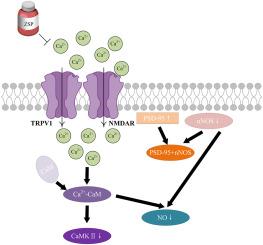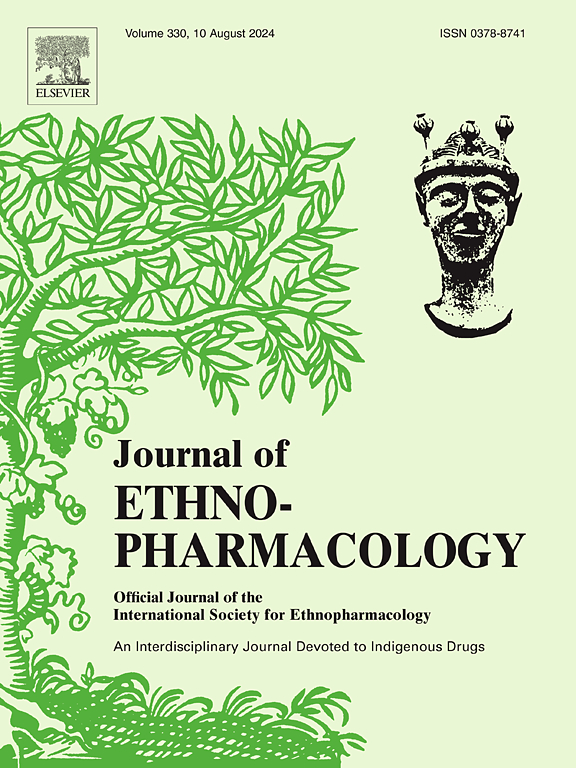Exploring the neuroprotective mechanism of the Mongolian medicine ZSP against acute ischemic stroke from TRPV1/NMDAR-mediated excitotoxicity
IF 5.4
2区 医学
Q1 CHEMISTRY, MEDICINAL
引用次数: 0
Abstract
Ethnopharmacological relevance
Zhachong Thirteen Flavored Pill, a classical preparation of Mongolian medicine, is a commonly used formula in Mongolian medicine for the treatment of ischemic stroke, and it has good clinical efficacy in both the acute and postictal phases of AIS. However, the mechanism of its treatment of AIS is still unclear.
Aim of the study: This study aims to elucidate the molecular mechanism by which Zhachong Thirteen Flavored Pill alleviates cerebral ischemia-reperfusion (MCAO/R) injury through targeted regulation of TRPV1 channels and their downstream signaling pathways, and to validate its neuroprotective effects.
Methods
At the cellular level, whole-cell patch-clamp was used to demonstrate the effect of Zhachong Thirteen Flavored Pill on the electrophysiology of TRPV1; the potential targets of Zhachong Thirteen Flavored Pill for the treatment of AIS were found through the use of network pharmacology, as well as the correlation between the core targets and TRPV1; MCAO/R model rats were replicated using the wire bolus method and divided into the sham-operation group, the model group, the edaravone group, as well as the equivalent dose and high dose of Zhachong Thirteen Flavored Pill groups. The effects of this formula on the volume of cerebral infarction in the MCAO/R model rats were evaluated by the mNSS scores, the grip traction test, and the TTC staining.
Results
Zhachong Thirteen Flavored Pill can target TRPV1, activate TRPV1 on TRPV1-HEK293 cells, and generate transmembrane currents; the core target is closely related to TRPV1; the binding energies of TRPV1 and NMDAR with CMGS, GCC, and LKL of AIS are all less than -7 kJ/mol; it can also lead to a increase in body weight of the MCAO/R model rat compared with that of the pre-modeling period, with no neurological deficits and normal muscle strength of the upper limbs. It reduced the infarct volume of rat brain tissue, upregulated the expression of NF-200 and NeuN, and downregulated the protein expression of Bax/Bcl-2, cytochrome C, and Cleaved-Caspase-3. The mRNA expression and protein expression of TRPV1, NMDAR1, NMDAR2B, pNMDAR2B, nNOS, CaMKII, and pCaMKⅡ were all downregulated compared with the model group.
Conclusion
By inhibiting TRPV1, regulating NMDAR/PSD-95/nNOS, down-regulating the expression of nNOS, Zhachong Thirteen Flavored Pill can attenuate neuronal apoptosis caused by excitotoxicity to alleviate neuronal damage, reduce the volume of cerebral infarction, improve neurological deficits and physical dysfunction, and exert neuroprotective effects.

从TRPV1/ nmdar介导的兴奋性毒性探讨蒙药ZSP抗急性缺血性脑卒中的神经保护机制。
民族药理学相关性:扎冲十三味丸是蒙药经典制剂,是蒙药治疗缺血性脑卒中的常用方剂,在AIS急性期和后期均有较好的临床疗效。然而,其治疗AIS的机制尚不清楚。研究目的:本研究旨在阐明扎冲十三味丸通过靶向调节TRPV1通道及其下游信号通路减轻脑缺血再灌注(MCAO/R)损伤的分子机制,验证其神经保护作用。方法:在细胞水平上,采用全细胞膜片钳法观察扎冲十三味丸对大鼠TRPV1电生理的影响;利用网络药理学发现了扎冲十三味丸治疗AIS的潜在靶点,以及核心靶点与TRPV1的相关性;采用丝丸法复制MCAO/R模型大鼠,分为假手术组、模型组、依达拉奉组、扎冲十三丸等剂量组和高剂量组。通过mNSS评分、握力牵引试验、TTC染色评价该方对MCAO/R模型大鼠脑梗死体积的影响。结果:扎冲十三味丸能靶向TRPV1,激活TRPV1- hek293细胞上的TRPV1,产生跨膜电流;核心靶点与TRPV1密切相关;TRPV1和NMDAR与AIS的CMGS、GCC和LKL的结合能均小于-7kJ/mol;可导致MCAO/R模型大鼠体重较造模前增加,无神经功能缺损,上肢肌力正常。降低大鼠脑组织梗死体积,上调NF-200、NeuN表达,下调Bax/Bcl-2、细胞色素C、Cleaved-Caspase-3蛋白表达。与模型组比较,TRPV1、NMDAR1、NMDAR2B、pNMDAR2B、nNOS、CaMKII、pCaMKⅡmRNA和蛋白表达均下调。结论:扎冲十三味丸通过抑制TRPV1,调节NMDAR/PSD-95/nNOS,下调nNOS的表达,减轻兴奋性毒性引起的神经元凋亡,减轻神经元损伤,减少脑梗死体积,改善神经功能缺损和躯体功能障碍,发挥神经保护作用。
本文章由计算机程序翻译,如有差异,请以英文原文为准。
求助全文
约1分钟内获得全文
求助全文
来源期刊

Journal of ethnopharmacology
医学-全科医学与补充医学
CiteScore
10.30
自引率
5.60%
发文量
967
审稿时长
77 days
期刊介绍:
The Journal of Ethnopharmacology is dedicated to the exchange of information and understandings about people''s use of plants, fungi, animals, microorganisms and minerals and their biological and pharmacological effects based on the principles established through international conventions. Early people confronted with illness and disease, discovered a wealth of useful therapeutic agents in the plant and animal kingdoms. The empirical knowledge of these medicinal substances and their toxic potential was passed on by oral tradition and sometimes recorded in herbals and other texts on materia medica. Many valuable drugs of today (e.g., atropine, ephedrine, tubocurarine, digoxin, reserpine) came into use through the study of indigenous remedies. Chemists continue to use plant-derived drugs (e.g., morphine, taxol, physostigmine, quinidine, emetine) as prototypes in their attempts to develop more effective and less toxic medicinals.
 求助内容:
求助内容: 应助结果提醒方式:
应助结果提醒方式:


